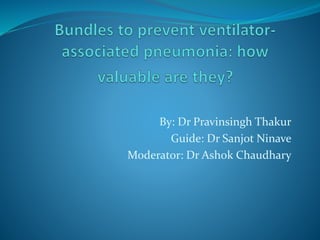
Bundles to prevent ventilator associated pneumonia
- 1. By: Dr Pravinsingh Thakur Guide: Dr Sanjot Ninave Moderator: Dr Ashok Chaudhary
- 2. Authors: Charity Wip and Lena Napolitano Journal : Current Opinion in Infectious Diseases 2009, Vol 22:159–166
- 3. Introduction Ventilator-associated pneumonia (VAP) is a common nosocomial infection in critically ill patients that is associated with poor clinical and economic outcomes including: - longer duration of mechanical ventilation - longer ICU and hospital stay - increased mortality - increased hospital charges
- 4. - VAP is the leading cause of death among nosocomial infections, exceeding rates of death secondary to central line infections, severe sepsis, and respiratory tract infections in nonintubated patients. - Accounts for approximately 17000 ICU days per year (2% of all ICU days) and 46 million dollars per year in the Canadian healthcare system [4].
- 5. Ventilator-associated pneumonia prevention guidelines VAP is preventable, and many practices have been demonstrated to reduce the incidence of VAP and its associated burden of illness. The Canadian Critical Care Trials group provides the summary of recommendations for VAP prevention:- 1. The orotracheal route of intubation should be used when intubation is necessary compared to nasotracheal . 2. Ventilator circuit changes:-New circuits for each patient, and changes if the circuits become soiled or damaged, but no scheduled ventilator circuit changes
- 6. 3. Changes of heat and moisture exchangers with each patient every 5–7 days and as clinically indicated 4. The use of closed endotracheal suctioning system compared to open system 5. Closed endotracheal suctioning system should be changed for each patient and as clinically indicated 6. Use of subglottic secretion drainage in patients expected to be mechanically ventilated for >72 h. 7. Use of rotating beds should be considered
- 7. VAP Bundle A Bundle can be defined as small, straightforward group of evidence-based set of practices - generally three to five - that, when performed collectively and reliably, have been proven to improve patient outcomes than if implemented individually. The Institute for Healthcare Improvement (IHI) developed the ‘Ventilator Bundle’ consisting of four evidence-based practices to improve the outcomes of patients requiring mechanical ventilation and provided the methodology for bundle implementation and measurement of compliance.
- 8. Components of Ventilator Bundle (1) Elevation of the head of the bed to 30 – 45 degrees. (2) Daily ‘sedation vacation’ and daily assessment of readiness to extubate. (3) Peptic ulcer disease prophylaxis. (4) Deep venous thrombosis (DVT) prophylaxis.
- 9. Evidence supporting Ventilator Bundle components Elevation of the head of the bed to 30 – 45 degrees:- - The semirecumbent position, achieved by elevation of the head of the bed, is an integral portion of the VAP bundle. - It has been speculated that the semirecumbent position may decrease VAP by reduction in gastroeso-phageal reflux and subsequent aspiration of gastrointestinal, oropharyngeal, and nasopharyngeal secretions.
- 10. Daily ‘sedation vacation’ and daily assessment of readiness to extubate:- - In many ICUs, patients are inconsistently evaluated for extubation on the basis of subjective assessment by caretakers. - Many patients are therefore inadvertently left intubated when they could have been extubated, thereby increasing their risk of VAP. - Sedation vacations are daily scheduled interruptions of sedation based on criteria. - If patients meet these criteria, their sedation is decreased or turned off in order to assess whether extubation criteria are met.
- 11. Peptic ulcer disease prophylaxis:- Although included within the Ventilator Bundle, this is not a specific strategy for VAP prevention. It was included in the Ventilator Bundle as a strategy to prevent stress related mucosal disease, as mechanical ventilation is a significant risk factor
- 12. Deep venous thrombosis prophylaxis:- Sedated ventilated patients are at significantly increased risk for DVT. Hence, DVT prophylaxis is an important component of standard care of these patients.
- 13. Potential additions to Ventilator Bundle Evidence-based recommendations included in the VAP prevention clinical practice guideline, but not the bundle (1) chlorhexidine antiseptic, (2) subglottic secretion drainage.
- 14. Conclusion VAP represents a large percentage of ICU-acquired infections and is associated with significant antibiotic utilization in the ICU and substantial morbidity, mortality, and costs. The Ventilator Bundle has been an effective intervention for VAP prevention in some institutions. Information from evidence-based VAP prevention guidelines suggests that the Ventilator Bundle should be modified to include additional effective VAP preventive strategies or a specific VAP bundle created to focus on VAP prevention.
- 15. References 1. Rello J, Ollendorf DA, Oster G, et al., VAP Outcomes Scientific Advisory group. Epidemiology and outcomes of ventilator-associated pneumonia in a large US database. Chest 2002; 122:2115–2121. 2 . Safdar N, Dezfulian C, Collard HR, Saint S. Clinical and economic consequences of ventilator-associated pneumonia: a systematic review. Crit Care Med 2005; 33:2184–2193. 3 . Cocanour CS, Ostrosky-Zeichner L, Peninger M, et al. Cost of a ventilator associated pneumonia in a shock trauma intensive care unit. Surg Infect (Larchmt) 2005; 6:65–72.
- 16. 4 . Muscedere JG, Martin CM, Heyland DK. The impact of ventilator-associated pneumonia on the Canadian healthcare system. J Crit Care 2008; 23:5–10.Important study that calculated resource utilization and cost data for VAP to the Canadian healthcare system. 5 . Muscedere J, Dodek P, Keenan S, et al., VAP Guidelines Committee and the Canadian Critical Care Trials group. Comprehensive evidence-based clinical practice guidelines for ventilator-associated pneumonia: prevention. J Crit Care 2008; 23:126–137.